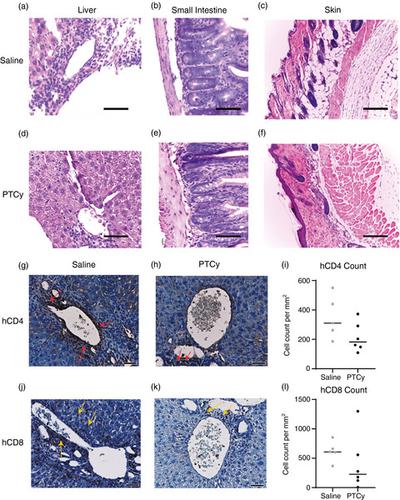当前位置:
X-MOL 学术
›
Immunology
›
论文详情
Our official English website, www.x-mol.net, welcomes your
feedback! (Note: you will need to create a separate account there.)
Post-transplant cyclophosphamide limits reactive donor T cells and delays the development of graft-versus-host disease in a humanized mouse model
Immunology ( IF 4.9 ) Pub Date : 2021-05-22 , DOI: 10.1111/imm.13374 Sam R Adhikary 1, 2 , Peter Cuthbertson 1, 2 , Leigh Nicholson 3 , Katrina M Bird 1, 2 , Chloe Sligar 1, 2 , Min Hu 3, 4 , Philip J O'Connell 3 , Ronald Sluyter 1, 2 , Stephen I Alexander 5 , Debbie Watson 1, 2
Immunology ( IF 4.9 ) Pub Date : 2021-05-22 , DOI: 10.1111/imm.13374 Sam R Adhikary 1, 2 , Peter Cuthbertson 1, 2 , Leigh Nicholson 3 , Katrina M Bird 1, 2 , Chloe Sligar 1, 2 , Min Hu 3, 4 , Philip J O'Connell 3 , Ronald Sluyter 1, 2 , Stephen I Alexander 5 , Debbie Watson 1, 2
Affiliation

|
Graft-versus-host disease (GVHD) is a major complication of allogeneic haematopoietic stem cell transplantation (allo-HSCT) that develops when donor T cells in the graft become reactive against the host. Post-transplant cyclophosphamide (PTCy) is increasingly used in mismatched allo-HSCT, but how PTCy impacts donor T cells and reduces GVHD is unclear. This study aimed to determine the effect of PTCy on reactive human donor T cells and GVHD development in a preclinical humanized mouse model. Immunodeficient NOD-scid-IL2Rγnull mice were injected intraperitoneally (i.p.) with 20 × 106 human peripheral blood mononuclear cells stained with carboxyfluorescein succinimidyl ester (CFSE) (day 0). Mice were subsequently injected (i.p.) with PTCy (33 mg kg−1) (PTCy-mice) or saline (saline-mice) (days 3 and 4). Mice were assessed for T-cell depletion on day 6 and monitored for GVHD for up to 10 weeks. Flow cytometric analysis of livers at day 6 revealed lower proportions of reactive (CFSElow) human (h) CD3+ T cells in PTCy-mice compared with saline-mice. Over 10 weeks, PTCy-mice showed reduced weight loss and clinical GVHD, with prolonged survival and reduced histological liver GVHD compared with saline-mice. PTCy-mice also demonstrated increased splenic hCD4+:hCD8+ T-cell ratios and reduced splenic Tregs (hCD4+ hCD25+ hCD127lo) compared with saline-mice. This study demonstrates that PTCy reduces GVHD in a preclinical humanized mouse model. This corresponded to depletion of reactive human donor T cells, but fewer human Tregs.
中文翻译:

在人源化小鼠模型中,移植后环磷酰胺限制了反应性供体 T 细胞并延缓了移植物抗宿主病的发展
移植物抗宿主病 (GVHD) 是同种异体造血干细胞移植 (allo-HSCT) 的主要并发症,当移植物中的供体 T 细胞对宿主产生反应时就会出现这种并发症。移植后环磷酰胺 (PTCy) 越来越多地用于错配的 allo-HSCT,但 PTCy 如何影响供体 T 细胞并减少 GVHD 尚不清楚。本研究旨在确定 PTCy 在临床前人源化小鼠模型中对反应性人类供体 T 细胞和 GVHD 发展的影响。用羧基荧光素琥珀酰亚胺酯 (CFSE) 染色的 20 × 10 6个人外周血单核细胞腹膜内 (ip) 注射免疫缺陷的 NOD-scid-IL2Rγ 缺失小鼠(第0天)。随后给小鼠注射 (ip) PTCy (33 mg kg-1 )(PTCy-小鼠)或盐水(盐水-小鼠)(第 3 天和第 4 天)。在第 6 天评估小鼠的 T 细胞耗竭并监测 GVHD 长达 10 周。在第 6 天对肝脏进行的流式细胞术分析显示,与生理盐水小鼠相比,PTCy 小鼠中反应性(CFSE低)人 (h) CD3 + T 细胞的比例较低。超过 10 周,与生理盐水小鼠相比,PTCy 小鼠体重减轻和临床 GVHD 减少,存活时间延长,组织学肝脏 GVHD 减少。PTCy 小鼠还表现出脾hCD4 + :hCD8 + T 细胞比率增加和脾 Tregs ( hCD4 + hCD25 + hCD127 lo) 与盐水小鼠相比。该研究表明,PTCy 可降低临床前人源化小鼠模型中的 GVHD。这对应于反应性人类供体 T 细胞的消耗,但人类 Tregs 的减少。
更新日期:2021-05-22
中文翻译:

在人源化小鼠模型中,移植后环磷酰胺限制了反应性供体 T 细胞并延缓了移植物抗宿主病的发展
移植物抗宿主病 (GVHD) 是同种异体造血干细胞移植 (allo-HSCT) 的主要并发症,当移植物中的供体 T 细胞对宿主产生反应时就会出现这种并发症。移植后环磷酰胺 (PTCy) 越来越多地用于错配的 allo-HSCT,但 PTCy 如何影响供体 T 细胞并减少 GVHD 尚不清楚。本研究旨在确定 PTCy 在临床前人源化小鼠模型中对反应性人类供体 T 细胞和 GVHD 发展的影响。用羧基荧光素琥珀酰亚胺酯 (CFSE) 染色的 20 × 10 6个人外周血单核细胞腹膜内 (ip) 注射免疫缺陷的 NOD-scid-IL2Rγ 缺失小鼠(第0天)。随后给小鼠注射 (ip) PTCy (33 mg kg-1 )(PTCy-小鼠)或盐水(盐水-小鼠)(第 3 天和第 4 天)。在第 6 天评估小鼠的 T 细胞耗竭并监测 GVHD 长达 10 周。在第 6 天对肝脏进行的流式细胞术分析显示,与生理盐水小鼠相比,PTCy 小鼠中反应性(CFSE低)人 (h) CD3 + T 细胞的比例较低。超过 10 周,与生理盐水小鼠相比,PTCy 小鼠体重减轻和临床 GVHD 减少,存活时间延长,组织学肝脏 GVHD 减少。PTCy 小鼠还表现出脾hCD4 + :hCD8 + T 细胞比率增加和脾 Tregs ( hCD4 + hCD25 + hCD127 lo) 与盐水小鼠相比。该研究表明,PTCy 可降低临床前人源化小鼠模型中的 GVHD。这对应于反应性人类供体 T 细胞的消耗,但人类 Tregs 的减少。











































 京公网安备 11010802027423号
京公网安备 11010802027423号